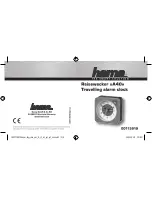
4.4 Technical Details on GPS, Antennas and Cables
23
Adjacent Signals
Although the standard RG-6 style cable is triple-shielded and has excellent shielding properties,
be cautious when routing near sources of high RF power, or alongside cables carrying high power
RF, such as transmitter cables. In these applications, consider using RG-11 style cable (P/N
WC0004900). Its quad-shielded design provides even more isolation.
Antenna Power
The RF preamplifier within the antenna requires 5 Vdc at 13 mA maximum for operation. A
power supply within the clock generates this voltage, which is applied to the antenna via the two
conductors of the coaxial antenna cable. Avoid shorting the center conductor to the shield of the
coaxial cable as it may damage the preamplifier. Conversely, a high-resistance connection or open
circuit would deprive the preamplifier of power. Either a short- or open-circuit condition in the
antenna cable will render the clock inoperable.
Prior to initial operation or if problems are suspected, perform the Antenna/Cable Operational
Test Procedure described in Section 4.2.
Connection to Antenna
The male Type F connector on one end of the antenna cable mates with the female Type F connector
on the antenna. Avoid placing mechanical stress on the cable attachment to the antenna.
Connection to Clock
The male Type F connector on the opposite end of the antenna cable connects to the female Type
F connector on the rear panel of the substation clock.
User-Supplied Antenna Cables
Any RF cable meeting the requirements described above for loss (
<
21 dB at 1575 MHz) and dc
resistance (
<
15 ohms total loop resistance) may be used with the clock. However, prior to using
a non-standard antenna cable, verify proper operation before installation.
For additional technical details concerning the GPS, GPS antennas and antenna cabling see
Appendix A, Technical Details and Specifications.
Summary of Contents for 1084A
Page 4: ...iv ...
Page 6: ...vi ...
Page 18: ...xviii LIST OF FIGURES ...
Page 24: ...4 Unpacking the Clock ...
Page 36: ...16 Connecting Inlet Power Input and Output Signals ...
Page 44: ...24 GPS Antenna and Cable Information ...
Page 114: ...94 Startup and Basic Operation ...
Page 123: ...B 4 Physical Dimensions 103 Figure B 1 Suggested Mounting of the AS0094500 Surge Arrester ...
Page 124: ...104 Using Surge Arresters ...
Page 134: ...114 Options List C 6 2 Option 06 Firmware Setup Figure C 3 Option 06 Firmware Setup ...
Page 142: ...122 Options List Figure C 5 Option 06 Output Jumper Settings ...
Page 158: ...138 Options List Figure C 13 Option 17 Board Layout and Jumper Locations ...
Page 163: ...C 13 Option 20A Four Fiber Optic Outputs 143 Figure C 14 Option 20A Jumper Locations ...
Page 170: ...150 Options List Figure C 16 Option 23 Internal Jumper Setup ...
Page 172: ...152 Options List Figure C 17 Option 27 Jumper Locations ...
Page 190: ...170 Options List Figure C 20 Option 29 Connector Signal Locations ...
Page 246: ...226 Options List ...
















































